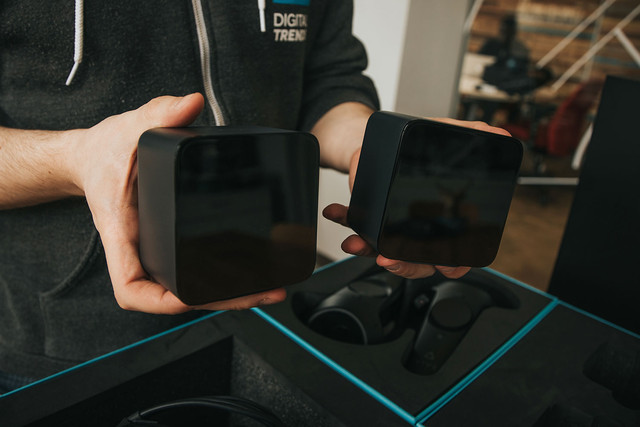
While the “Lighthouse” Base Stations are currently among the most expensive components required for SteamVR Tracking, future innovations could simplify their inner workings without impacting performance, reducing the buy-in price for an HTC Vive setup by $100 or more.
Currently, SteamVR Tracking requires two Tracking Base Stations to function — a requirement that contributes to the HTC Vive’s high price point. A replacement Tracking Base Station costs $134 through HTC’s online storefront, which “may be the single most expensive part of the Vive system beyond the headset — and you need two of them,” according to Road to VR.
Valve Engineer Ben Jackson proposed a cost-cutting solution at Valve’s recent Steam Dev Days event. According to Jackson, current Tracking Base Stations use a pair of motors to track motion. Each motor requires its own controller and laser diode, among other costly components, driving up the unit’s price significantly.
Jackson proposes a single-motor solution that essentially cuts the Tracking Base Station’s hardware production requirements in half. In Jackson’s design, a single motor generates a V-shaped laser pattern within the VR play area, gathering ‘X’ and ‘Y’ axis information simultaneously without the need for an additional motor for fine-tuned tracking.
“What better way to make [the Base Station] lighter, quieter, cheaper, and more power-efficient than to chop out half the parts?” Jackson asks.
Triad Semiconductor’s Reid Wender also foresees “rapid cost reductions” stemming from potential Tracking Base Station redesigns. While Valve has not announced plans to redesign current Base Station units, Road to VR estimates that cost-cutting measures could reduce the base price of the HTC Vive to $665, or “about 17 percent less than the current price.”
Editors' Recommendations
- As others hype up VR and the metaverse, Valve may be backing away
- Everything HTC announced at ViveCon 2021: Vive Focus 3 and Vive Pro 2
- Two new ‘game-changing’ VR headsets could arrive at HTC’s ViveCon next week
- Apple reportedly working on an AR headset with Vive-like controllers
- HTC offers cheaper Vive Pro Eye bundles, expands eye-tracking in VR


